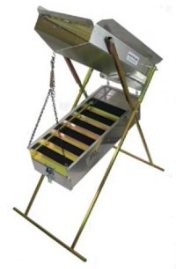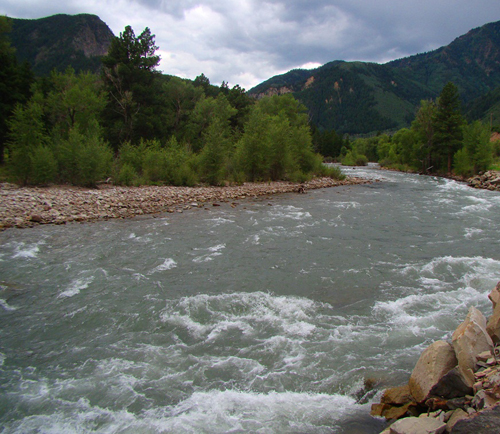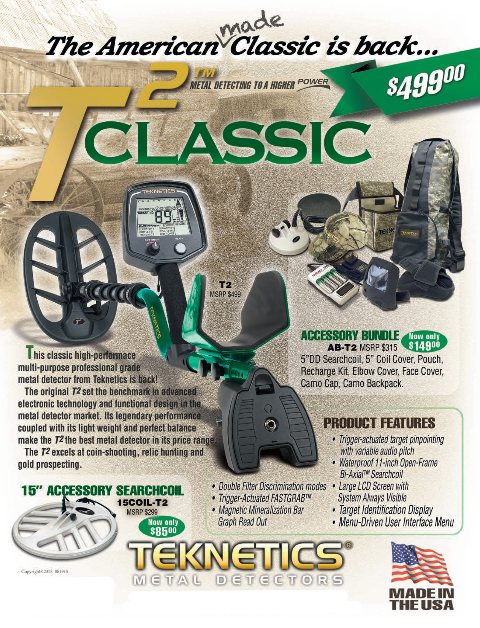Monday, July 25 2016
The following is an excerpt from the extensive and informative "Going Cubular" article that appears in the Whether you're prospecting in a stream or desert, mine alone or run a large operation, chances are you've seen or personally operated a Gold Cube. This super concentrator is everywhere! Mike Pung, the co-inventor, demonstrates this workhorse at all the GPAA Gold & Treasure Shows, and it's been made famous on the GPAA-produced Gold Trails and on the Discovery Channel's Gold Rush and Bering Sea Gold reality TV shows. The celebrities all use it, including Dakota Fred, Parker Schnabel, Todd Hoffman, Vernon Adkison, and Emily Riedel. Save Time with the Gold Cube Why do so many famous gold miners, as well as average guys and gals, use the Gold Cube? Because it saves time. Lots and lots of time! "What would normally take about 8 hours of cleanup with a gold pan is reduced down to about an hour with the Gold Cube," explains Mike Pung. "Anybody with a lot of concentrates or who has a dredge or if you're running a big operation views the Gold Cube as more of a clean up tool. But to many recreational prospectors and small-scale miners, the Gold Cube is their primary piece of equipment in the field. The Gold Cube can process the black sands and hold the fine gold like no other machine, hence the slogan Cube It or Lose It!" Fine gold is defined as anything that is 20 mesh and smaller (mesh refers to the number of holes per linear inch in a screen or classifier). "Once you start getting down below 20 mesh, if you're not using a Gold Cube, you are blowing out most of the fine gold. You are keeping the big stuff, but are losing a lot of fine gold. If it's 50 mesh and minus and you are using a sluicebox, you're losing most of that gold if you're running continuously all day," says Mike. How the Gold Cube was Invented Mike Pung was bitten by the gold bug in 2006 and met co-inventor Steve "Red" Wilcox shortly after his first trip to the Klondike. Besides sharing a passion for prospecting, the two men shared a common enemy: black The Gold Cube is designed to handle up to 1,000 pounds of material an hour. "It can take a thousand pounds of dirt per hour and reduce that material down to a cup and a half of concentrates," said Pung. "If you put a cup and a half in there, you are going to end up with a cup and a half. But if you shovel a half ton of dirt into it, you will still end up with a cup and a half. The longer you run it, the more it's going to concentrate. It's not the number of buckets you have to monitor. It's the weight of the material. For example, 1,000 pounds of regular gravel amounts to about 16 to 18 buckets, whereas the black sands along Lake Superior are much heavier, so 1,000 pounds of material may fit in only 4 or 5 buckets." How the Gold Cube Works Imagine a fine gold particle, 19.3 times heavier than the moving water that suspends it. The trick is to use the water to separate the lighter material from the heavier, through stratification or layering. "The low pressure zone behind a riffle is called an eddy which rolls horizontally, and the vortex churns vertically like a tornado," explains Mike. "What happens is the vortex churns the material, separates the lights from the heavies, and the gold sinks to the btoom. And when it sinks, it stays there until something heavier wants to displace it. As gold sinks to the bottom of a vortex pocket that's already full, it will displace something equal to its size. The Gold Cube and the vortex technology basically operates on a replacement system, so when you've got something heavy it sinks and something else has to get kicked out, so heavier just keeps replacing lighter material. The longer you run it, the heavier that pocket is going to get. And once it is completely full, it's going to have to find another pocket because that pocket is full of gold. Which is not a bad problem to have!" Is a 3 Stack or 4 Stack Best?
The rounder the gold, the faster it's going to sink. If you have fine three dimensional gold you're probably never going to see any gold past the first 2 or 3 inches of the very first try unless you've completely loaded it up with gold. It's going to find some place to sit... that's called hydrodynamics. Mike Pung explains further, "If you've got three dimensional gold closer to the source, you know that all you're going to need is a three-stack Gold Cube because the first tray is going to catch most of the gold." G Force Separator In the G-force separator where the Gold Cube trays drop down and around, the water whips around the bend. Get Rid of Those Bubbles! Setting up your Gold Cube for the first time is not too difficult; some say the hardest part about setup is putting together the stand. It will take 10 or 15 minutes and most of that time is spent getting the mats very wet. You must make sure the mats are wet all the way down to the bottom of the vortex pocket so they don't hold a bubble. If they hold a bubble, gold can ride right over the top of it. Getting rid of the bubbles is very important! If your mat is wet and it looks like there are a bunch of diamonds shining in the sunlight in there, those are really bubbles and that's not where the gold is going to sit. There are 7,000 vortex pockets on that mat. To get rid of the tiny air pockets, put your thumb over the end of a hose to create water pressure to force the water in deep while spraying the mats. When your mat looks black and not shiny with bubbles, you will get good gold retention. There are two main accessories available for use with either the three stack or four stack units. Gold Banker: The Gold Banker is placed over the Gold Cube and serves as a built-in classifier with spray bar, which eliminates the need to classify material before running it. It's available in Stainless (recommended for salt water) or an Anodized punch plate. If you're a rockhound, you'll want a Gold Banker. "You've never had a better way to look at rocks because they're clean and wet. I've found arrowheads, petrified wood, gems, and all kinds of stuff in the Gold Banker," says Mike. Trommel: The trommel allows you to shovel unclassified dirt and rock directly into the hopper. The trommel (16 inch long barrel x 5 inch diameter, classifying to 3/16 inch) then trumbles and washes the material before it enters the Gold Cube trays. Ready to "Go Cubular?!" Click here for more information, to watch videos, and to order the Gold Cube and/or accessories. Saturday, July 02 2016
Although there are many variables that go into catching gold in a sluice, perhaps properly “tuning” your sluice is the most critical. A few months ago, Steven “Doc” Vetter, owner of Gold Hog brand mats, wrote an interesting article for Gold Prospector Magazine that focused on a few key factors that all miners should pay attention to. The following ideas from his article are all about achieving the proper tuning exchange, meaning letting the junk flow out, or be worked out by exchange zones, and holding the stuff you do want—gold. A well-tuned sluice will have heavy gold concentrations up top, medium gold in the middle, and trace gold near the end Hydraulic Equivalence: By definition, “hydraulically equivalent” (HE) refers to particles of varying size, shape and density that fall out of a water flow and deposit in the same area. While quartz rock and gold vary greatly in specific density, you can make them collect in the same place by making the quartz rock bigger and rounder. A 2 inch quartz rock and a 1 mm sphere of gold will fall through water and deposit in about the same place— making them hydraulically equivalent (HE). An opposite example is a .25 inch round piece of gold and a .25 inch round piece of quartz. The gold will sink through the water and likely land straight down. The quartz rock, however, will not fall as fast and will be pushed several feet away before it settles. These two items are not HE. The shape of the gold has a big influence on its HE. Flat things move more easily than spheres when either moving water or air is introduced. HE is a huge factor in gold mining and is often the main reason for classifying material to a certain size— the theory being if everything is about the same size, the heaviest material will stay in the sluice. When you slow down a sluice, you start to have a traffic jam. Things that are HE all want to gather in the same deposit zone and you start to gather/open the window for more non-gold particles to pile up and that’s not good. Incremental Processing: A great analogy of how this principle works is to picture a city bus. Imagine a rule where all passengers must enter through the front and must exit through the back. As they enter, passengers must fill the seats in the front of the bus first. Every time the bus makes a stop (you shoveling dirt into the hopper of your highbanker or sluice), the first few rows fill up quickly and remain full for a short period of time. As a new passenger (each new shovel full of material) gets on and finds the front seats taken, he must move further down the bus (sluice). The result is a bunch of folks all competing for the same seats up front and when there are no seats up front, they must take the next available one. If all the seats get full, a passenger (your paydirt) never even gets to sit down and exits the bus (sluice) without ever sitting (collecting in the riffles). As the working zones in your sluice fill up, slurry material will move down to the next zone before it settles there. During times of heavy loading, the first percentage of your sluice will load up heavy and take some time to exchange out. That means gold will keep traveling until it finds an “empty seat.” If you load too heavy or have too short of a sluice, you’ll have gold flowing over holding zones that are busy working and exchanging. It may take an exchange center (vortex) 3 or 5 seconds to fully process down material and exchange out non-gold and heavies. Fine Tuning: Because of the principles of Hydraulic Equivalence and Incremental Processing, you may have realized that slowing down a sluice can really cause problems and loss of gold. How do you know if your sluice is running too fast or too slow? Experiment! Of course doing so is a little scary because the #1 fear of most gold miners is losing gold, and quite honestly, until your sluice is fine tuned, that just might happen. To avoid losing gold, most miners start running their sluice at the “normal” or widely accepted pitch of 1 inch per foot. But this is just a starting point. If you see gold in your tailings, your first thought is probably to slow it down so you aren’t blowing gold out of the sluice. But perhaps that’s not the cause at all. Perhaps it’s because gold doesn’t have a place to sink down into and hide in your sluice. Experiment by running way too fast, say at a 15-degree pitch. Then take it to 13 degrees, then go down to 12.5. Keep adjusting until you find an acceptable capture rate for the size of gold you want to hold. Lose your fear of losing gold through testing and experimentation. Not only will you fine tune your sluice, but you’ll also get a great education. Good luck! Monday, June 27 2016
In case you hadn't heard the exciting news... Garrett recently introduced three new detectors in the ACE series— the 200, 300 and 400! Each of the new ACE detectors include Digital Target ID—a large, 100-digit target information display for better target identification—as well as a more robust audio package, and stem locks for additional strength and stability. With the great pricing and features, it's no wonder that all three detectors have proven to be fast movers as soon as they hit the market!
It's healthy to take a break once in a while from the office, the grind, and the daily pressure— especially with great weather and long hours of daylight. Grab your metal detector and get out there— wherever your “there” might be. Take your detector along on a camping trip or on your next hike. And don't forget coin shooting in the park (kids love it!). You never know when you might encounter some long-forgotten site that’s just waiting to be hunted by YOU! Summer is the perfect season for metal detecting and the ideal time to unwind and search for your next great find! Good luck hunting! Wednesday, May 04 2016
GoldRushTradingPost.com is off-line and the office is closed until June 20, 2016. We sincerely apologize for the inconvenience. During the temporary closure, the website cannot accept orders, and no customer service will be available via email or phone. Once we are back in the office on June 20, it's business as usual. We appreciate your understanding. Thank you! Sunday, April 03 2016
This year's Gold Prospecting and Mining Summit will be at the El Dorado County Fa Event admission is $5 and parking is also $5. Kids under 12 are free with a paid adult. Gold panning is available for children, as well as a free scavenger hunt. Food and drinks available for purchase. RV camping available at the fairgrounds or choose a nearby hotel. In addition, there will be an Ask The Experts booth staffed with experts in panning, detecting and mineral processing. Bring your questions! There's a suggested donation of $2 (with all proceeds going to Public Lands for the People) but a donation is certainly not required!
Lecture Schedule:
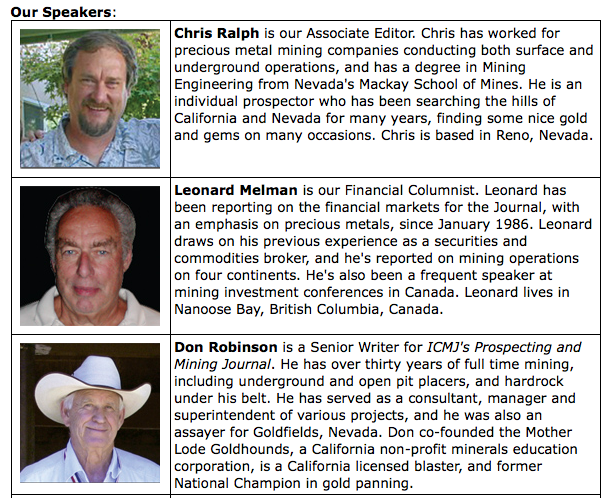
Get all the details of ICMJ's 2016 Mining Summit here. While in Placerville, you might also want to check out these other nearby activities:
Monday, February 01 2016
A drywasher is a machine that uses air, vibration, and static electricity to effectively separate gold from waste Drywashers are operated by shoveling gold-bearing gravels into an upper box which is covered with a screen. The larger rocks that are too big to pass through the screen slide off. Gravel small enough to go through is fed down into the lower gold recovery box, which is an inclined trough with cross riffles much like a sluice. The bottom of the recovery box consists of a thin, light-weight porous cloth. Beneath the riffle box is a blower that pulses air up through the cloth. The vibrations and air flow, combined with the shaking and classifying action of the dry washer allows the gold to settle to the bottom where it is captured in the riffles. With weather experts forecasting the strongest El Nino in half a century, dry washing should be very lucrative this winter. After being dry for so long, the predicted flash floods and high water events will replenish previously "worked out" areas. After all, nothing moves gold like water! Heavy rains and strong winds will cause erosion and mudslides that in turn move sands, gravel, rocks and even large boulders. The greater the volume and velocity of the water, the larger the gold and the further distance it will be moved until the water slows and the gold settles. As the fast-moving water eventually slows, "new" gold that has been unearthed will drop out of suspension and settle where it may, creating a layer of flood gold on or close to the surface. If El Nino is as strong as predicted, you'll find gold on the surface and maybe only 8 or 10 inches down, which means a lot less digging. Following a flash flood, you’ll often see black sand on the surface because it didn’t have enough time to work its way down. This clue tells you to do a test pan. You can dry pan or carry a little water. Test panning is a good idea even if the ground itself is too wet to drywash just yet. It’s never too wet to classify and prep the material to dry out in the sun! Once the floods are over and the dirt dries out, take advantage of the conditions and get out there with a drywasher. And when you do, keep these tips in mind:
NOTE TO CALIFORNIA PROSPECTORS: At a time when California legislators have refused to issue suction dredge permits to miners, dry washing may soon be the only unregulated activity left in the Golden State! With the new state-wide restrictions under Senate Bill 637 on the use of high bankers and suction dredges, some prospectors are starting to find a lot of gold deposits using dry washers in the California Mother Lode country. Good luck! Shop for a drywasher here and enjoy FREE SHIPPING in the Lower 48 on $350 purchases! Nugget of News Blog Monday, January 04 2016
Whether young, old, or somewhere in the middle, the shows offer something for everyone and provide the best opportunities to learnnew skills, see product demos, and rub elbows with some of the most respected miners and metal detectorists in the business! Mark your calendars and we'll see you there! Tuesday, December 01 2015
With the weather turning colder, you might think you're done prospecting 'til next summer, but you don't have to be! Even if you're not a regular snowbird heading to a warmer climate for the next few months, Gold mining in the desert is especially enjoyable if you're not into crowds— the desert can be delightfully smog free and people free in the winter. Experts say there is just as much gold waiting to be taken out of the desert as there is commonly found in streams and rivers. Why? Well, throughout history the desert mines just never got the publicity that wet places like California's Mother Lode did, so fewer prospectors went there. Plus, back in the day, mining used to be harder in dry conditions. Luckily that's no longer true if you have the right equipment.
• Metal detecting is another great way to hunt for gold in the desert. Gold detectors are not necessarily higher in cost, but they are built with a higher sensitivity to detecting gold nuggets, and have better ground balancing and • A bonus of prospecting in the desert is the abundance of interesting rocks. You can find many unusual rocks and semi-precious gems such as tourmaline, turquoise, agate, jasper, and more. Lapidary shops can cut and polish the rocks for you, or buy your own rock tumbler and lapidary tools and learn a new hobby. This winter, consider extending your gold-getting season with a prospecting trip to a sunnier, warmer state. Good luck and have fun! Wednesday, October 28 2015
By now you’ve probably heard that climatologists are predicting that the winter of 2015-2016 will be unusual because of “El Niño.” An El Niño weather pattern is a periodic warming of the central and eastern equatorial Pacific "There's no longer a possibility that El Niño wimps out at this point. It's too big to fail," Bill Patzert, a climatologist for NASA's Jet Propulsion Laboratory, told the LA Times. "And the winter over North America is definitely not going to be normal." Most farmers and ranchers in the West are hopeful that these predictions are correct, especially those in California and other states that have been plagued by years of drought. Gold miners are generally hopeful because lots or rain and flooding moves gold around and re-deposits it. While terrible property damage can occur, depending on the severity of the storms, flooding can cause the renewal and reformation of pay streaks and refill crevices with gold. If flooding does move around some gold over the winter, there will be great opportunities in many Western gold-bearing areas come next spring and summer! The consensus of many experts is that El Niño will persist through winter 2015-2016, before weakening, as most of these weather patterns typically do, in spring 2016. Mike Halpert, the deputy director of the Climate Prediction Center, said this El Niño is the second strongest he's seen at this time of the year. "The atmospheric response to the equatorial sea-surface temperature anomalies, measured by their atmospheric ENSO index (AEI), is the strongest event since at least 1948," said Dr. Todd Crawford, chief meteorologist at WSI, the professional division of The Weather Company. According to NOAA (National Oceanic and Atmospheric Administration is a federal agency focused on the condition of the oceans and the atmosphere), the winter of 1997 was the second warmest and seventh wettest on record. Severe weather included flooding in the southeast and California, an ice storm in the northeast, and tornadoes in Florida. During that winter, Oklahoma had some its warmest temperatures and wettest weather. Of course California miners didn’t advocate for the destruction caused by the floods, but they were pretty happy with the resulting redistribution of gold in rivers and areas that previously had been “played out.” Mother Nature has a way of replenishing gold! Looking at past moderate-strong El Niño, here are the predictions for temperatures and precipitation from late fall 2015 through spring 2016 across the country: Wetter: Southern U.S. from California to the Carolinas then up parts of the East Coast Drier: Parts of the Ohio Valley, Great Lakes, Northwest and Northern Rockies Cooler: Desert Southwest, Southern Plains, northern Gulf Coast Warmer: Northern tier of states from the Pacific Northwest to the Northern Plains, Great Lakes, and Northeast The scientific evidence for El Niño seems strong right now, but it’s still a little bit early to say for sure about the strength of the upcoming storm patterns. Still, if you’re planning your prospecting trips and activities for the next six months, you might want to consider the potential golden bonanza an El Niño might bring! Thursday, September 24 2015
This detector comes with an 11-inch elliptical Bi-Axial searchcoil for maximum detection depth in mineralized soils. An accessory bundle for the T2 includes a smaller coil, backpack, hat, and more is also available (additional charge). This machine is light weight and the best balanced of any high-performance metal detector, so you can hold and swing it almost effortlessly. The armrest position is adjustable to fit your arm. The grip is durable high-friction foam elastomer, comfortable in any kind of weather. The controls are conveniently located and easy to learn how to use. Locking collars on the tubes eliminate rattling. The entire menu is always visible on the LCD display. The LCD display indicates the electrical signature (Target-ID) of the detected metal object. The display provides continuous information on battery condition and on ground mineralization, which affects detection depth. Help messages are automatically displayed on the lower right corner of the display when necessary. A great benefit of the Teknetics T2 is that it is easier to learn to use properly than other comparable metal detectors. A few of its best features inclue:
The T2 is powered by four AA alkaline batteries, which will typically last for more than 40 hours of use before needing replacement. The lead engineers on the design team were John Gardiner, firmware engineer, and David Johnson, whose expertise is behind many of the best-known high-performance metal detectors offered by major U.S. manufacturers for the last 26 years. 5 year manufacturer warranty from First Texas Products, LLC. Most metal detectors, like the Teknetics T2, use VLF Induction Balance technology. Here’s how it works: The searchcoil (also called search head or loop) contains two electrical induction coils which are like antennas. One coil transmits a rapidly alternating magnetic field, illuminating the region surrounding the searchcoil. If metal is present, its electrical conductivity distorts the magnetic field. If iron metal is present, its magnetism also distorts the magnetic field, but in a different way, allowing the metal detector to distinguish between ferrous and nonferrous metals. The other coil is a receiving antenna which detects changes in the magnetic field caused by the presence of metal. Electronic circuits amplify this weak signal, analyze it to determine the changes which occur as the searchcoil sweeps over the target, and then convey the information to the user in the form of a visual display or audio tones. Most modern metal detectors perform many of these tasks in software running on an internal microcomputer. The iron minerals which are present in most soils also distort the magnetic field, obscuring the weak signals of small or deep objects. This can cause the object to go undetected, or to be misidentified when it is detected. Much of the technology that goes into modern metal detectors is devoted to the task of eliminating the unwanted signals from iron minerals in the soil, while not losing the signals from metal objects. If you're considering a multi-use detector that's ideal for relic hunting, coin shooting, and gold prospecting, learn more here about Teknetics T2 Metal Detector and/or download the operating manual. |
|
Nugget of News Blog |






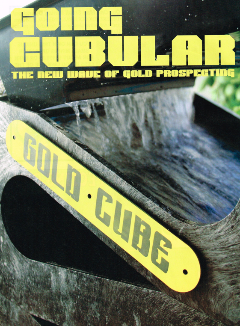
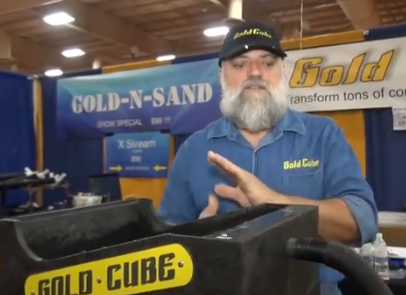 sands. The real reason the Gold Cube was invented was their nemesis— fine
sands. The real reason the Gold Cube was invented was their nemesis— fine  gold. Like any great invention, the Gold Cube was born out of necessity, to solve a real problem, but the process held plenty of struggle and strife. While perfecting the prototypes, the funniest thing Red said to Mike was "Don't believe everything you think!" Their good-natured bickering was actually very productive and the first Gold Cube rolled off the production line in November 2010 (made in the USA, of course) and the first unit was sold in December. Sales have been steady and strong ever since! And just like any gold miner would stake a claim after striking gold, Pung and Wilcox have been issued two patents— both a design and utility patent.
gold. Like any great invention, the Gold Cube was born out of necessity, to solve a real problem, but the process held plenty of struggle and strife. While perfecting the prototypes, the funniest thing Red said to Mike was "Don't believe everything you think!" Their good-natured bickering was actually very productive and the first Gold Cube rolled off the production line in November 2010 (made in the USA, of course) and the first unit was sold in December. Sales have been steady and strong ever since! And just like any gold miner would stake a claim after striking gold, Pung and Wilcox have been issued two patents— both a design and utility patent.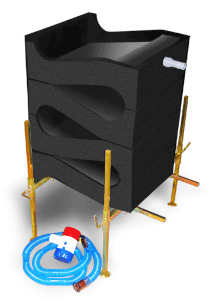 Deciding whether to go with a three-stack or four-stack depends on the type of gold itself. The flatter something is, the more it acts like a kite. Kiting is when the gold is so flat that it catches water, flips, and then sails over the waves. The flatter the gold, the more you'll require a
Deciding whether to go with a three-stack or four-stack depends on the type of gold itself. The flatter something is, the more it acts like a kite. Kiting is when the gold is so flat that it catches water, flips, and then sails over the waves. The flatter the gold, the more you'll require a 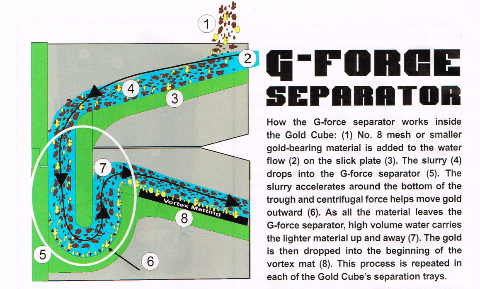 The fine gold becomes heavier and is moved to the outside edge because of centrifugal force. The gold drops to the bottom and starts scooting up that wall. And, as it leaves the G-force separator, it hits a lip just before it gets to the vortex mat. That edge is the only eddy in the entire system— a low-pressure zone necessary to pull the gold in front of the mat. With a sluicebox, you try hard to get the gold underwater, but with a Gold Cube, the gold doesn't have a choice; it goes under water, under that gate and the low pressure eddy exiting the G-force separator sucks the gold right up in front of the mat. The gold has nowhere to go except into the matting.
The fine gold becomes heavier and is moved to the outside edge because of centrifugal force. The gold drops to the bottom and starts scooting up that wall. And, as it leaves the G-force separator, it hits a lip just before it gets to the vortex mat. That edge is the only eddy in the entire system— a low-pressure zone necessary to pull the gold in front of the mat. With a sluicebox, you try hard to get the gold underwater, but with a Gold Cube, the gold doesn't have a choice; it goes under water, under that gate and the low pressure eddy exiting the G-force separator sucks the gold right up in front of the mat. The gold has nowhere to go except into the matting.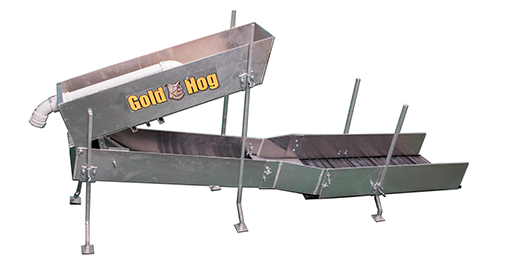
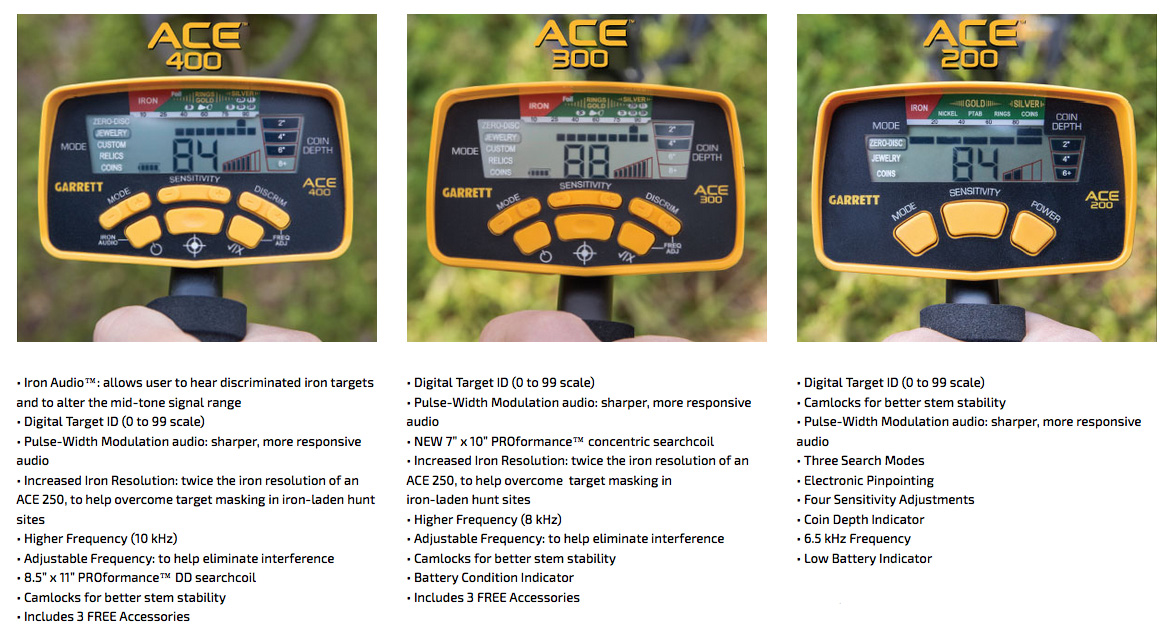


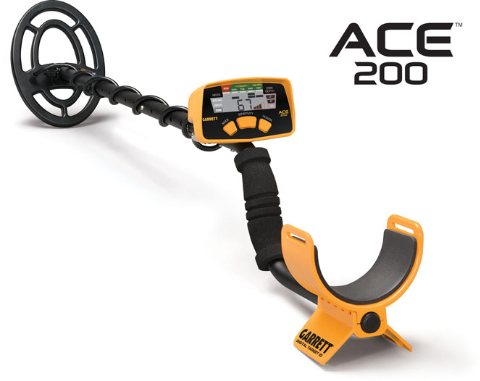

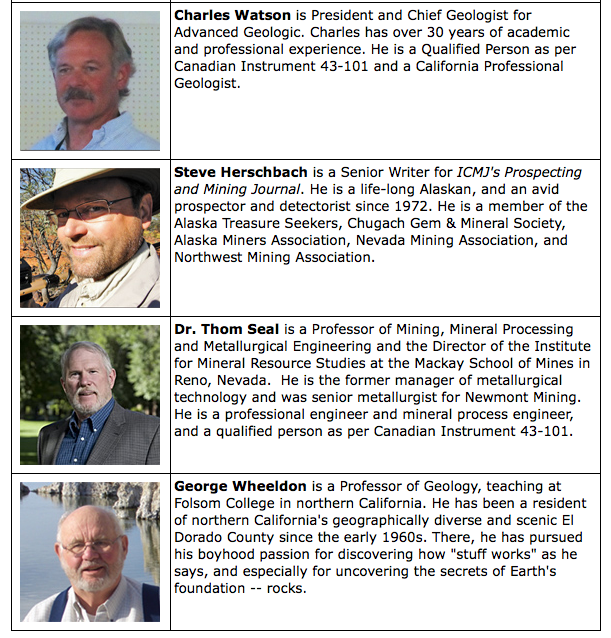
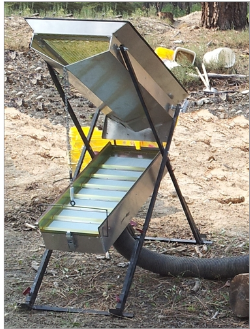
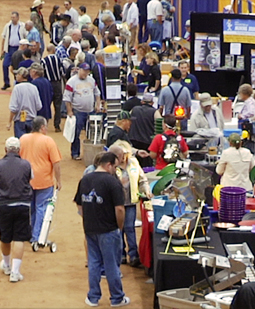 If you’ve been thinking that mining for gold, metal detecting, or rockhounding seem like exciting hobbies you and your family would like to start, or if you've been doing it for years and just want to find out what's new in the industry, then make plans this spring to attend a Gold Prospectors Association of America (GPAA) Gold & Treasure Show and/or the 2-day ICMJ Prospecting & Mining Summit.
If you’ve been thinking that mining for gold, metal detecting, or rockhounding seem like exciting hobbies you and your family would like to start, or if you've been doing it for years and just want to find out what's new in the industry, then make plans this spring to attend a Gold Prospectors Association of America (GPAA) Gold & Treasure Show and/or the 2-day ICMJ Prospecting & Mining Summit.